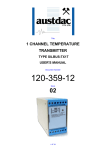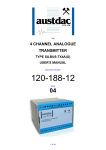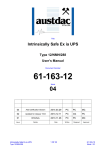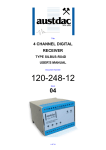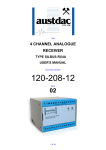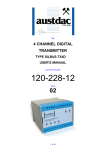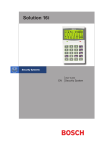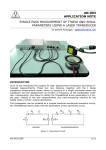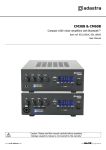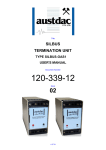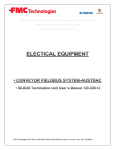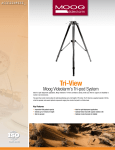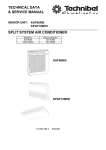Download user manual
Transcript
Title 2 CHANNEL FREQUENCY TRANSMITTER TYPE SILBUS-TX2F USER'S MANUAL Document Number 120-379-12 Issue 01 1 OF 24 REVISION CONTROL 01 Original 2012.08.20 PB’ CG PC Issue Details Date Written Designed Approved Austdac Pty Ltd Unit 1 / 4 Packard Avenue Castle Hill NSW 2154 Australia PO Box 6486 Baulkham Hills Business Centre NSW 2153 Australia Phone: + 61 2 8851 5000 Fax: + 61 2 9899 2490 Website: www.austdac.com.au Austdac Inc. 455 Lowries Run Rd, Pittsburgh, PA 15237 USA Phone: +1 888 254 9155 Fax: +1 412 635 0179 Copyright 2009-01-19 This document remains the property of Austdac Pty. Ltd. It is subject to its recall and must not be reproduced in part or whole or its contents divulged to third parties without prior written approval from Austdac Pty Ltd. 2 CHANNEL FREQUENCY TRANSMITTER TYPE SILBUS-TX2F USER'S MANUAL 2 OF 24 120-379-12 Issue: 01 TABLE OF CONTENTS REVISION CONTROL .................................................................................................................... 2 TABLE OF CONTENTS .................................................................................................................. 3 PHOTOGRAPHS ............................................................................................................................ 3 TABLES .......................................................................................................................................... 4 FIGURES ........................................................................................................................................ 4 1 GENERAL DESCRIPTION .......................................................................................................... 5 2 FRONT PANEL LAYOUT ............................................................................................................. 5 3 THEORY OF OPERATION .......................................................................................................... 6 4 OPERATING INSTRUCTIONS .................................................................................................... 9 5 CONFIGURATION ....................................................................................................................... 9 5.1 CONSOLE PORT OPERATION ............................................................................................ 9 5.2 HELP COMMAND ............................................................................................................... 10 5.3 REPEAT COMMAND .......................................................................................................... 11 5.4 VERSION COMMAND ........................................................................................................ 12 5.5 STACK COMMAND ............................................................................................................ 12 5.6 SILBUS MAP COMMAND ................................................................................................... 12 5.7 SILBUS STATUS COMMAND............................................................................................. 13 5.8 SILBUS GET COMMAND ................................................................................................... 13 5.9 FREQUENCY INPUT ADDRESS COMMAND .................................................................... 14 5.10 TRIP POINT ADD COMMAND .......................................................................................... 14 5.11 SET POINT DELETE COMMAND ..................................................................................... 15 5.12 TRIP SET POINT HYSTERESIS COMMAND ................................................................... 16 5.13 ANALOGUE SELECT COMMAND .................................................................................... 16 5.14 FREQUENCY INPUT COMMAND .................................................................................... 17 5.15 FASTLINK MARKER COMMAND ..................................................................................... 17 5.16 UPLOAD CONFIGURATION COMMAND ......................................................................... 18 5.17 DOWNLOAD CONFIGURATION COMMAND ................................................................... 19 6 TERMINATIONS AND CONNECTIONS .................................................................................... 21 6.1 FREQUENCY INPUT PORTS ............................................................................................. 21 6.2 SILBUS NETWORK PORT ................................................................................................. 22 7 CERTIFICATION ....................................................................................................................... 23 8 SOFTWARE REVISION AND DISPLAY .................................................................................... 23 9 SPECIFICATIONS ..................................................................................................................... 24 PHOTOGRAPHS Photograph 1 SILBUS-TX2F front panel ......................................................................................... 5 Photograph 2 Access to console port and programming switch ...................................................... 6 Photograph 3 Austdac air velocity sensor ....................................................................................... 8 Photograph 4 SILBUS-TX2F console port connected to MEAN1 interface .................................... 10 Photograph 5 Hyper Terminal delay setup .................................................................................... 20 Photograph 6 Correctly prepared input cable ................................................................................ 22 2 CHANNEL FREQUENCY TRANSMITTER TYPE SILBUS-TX2F USER'S MANUAL 3 OF 24 120-379-12 Issue: 01 TABLES Table 1 Frequency to air velocity conversion .................................................................................. 7 Table 2 Status LED flash sequence meanings ................................................................................ 9 Table 3 SILBUS-TX2F Configuration record ................................................................................. 21 Table 4 Frequency input termination details .................................................................................. 22 FIGURES Figure 1 SILBUS-TX2F input stage schematic ................................................................................ 7 Figure 2 SIBUS-TX2T Connection diagram................................................................................... 21 2 CHANNEL FREQUENCY TRANSMITTER TYPE SILBUS-TX2F USER'S MANUAL 4 OF 24 120-379-12 Issue: 01 1 GENERAL DESCRIPTION The two channel frequency transmitter is part of a family of explosion protected DIN rail mounting modules that transmit to and receive from an Austdac SILBUS field bus network. The SILBUS-TX2F can transmit up to two frequency or pulse signals on two independent valid SILBUS channels. The two frequency or pulse inputs are designed to work with galvanically isolated voltage free contacts within the sensing device such as an Austdac Anemometer type AGD1. This makes the SILBUS-TX2F particularly suited to monitoring ventilation air flow via the SILBUS network without any requirements for additional power. The transmitter is housed within a DIN rail mounting enclosure measuring 45mm (W) x 75mm (H) x 110mm (D). The front panel is located between the two top of enclosure mounted terminal blocks to provide a clear view of the operation indicating LED’s. Three LED’s are provided to show input channel status and SILBUS network status. The SILBUS-TX2T can be quickly and simply configured using a laptop computer running Hyper Terminal and a small plug in programming adaptor. Each frequency input can be independently programmed to any SILBUS channel address. Each frequency input can also have it’s under range, hysteresis, digital fault channels and transmission protocol configured by the user. 2 FRONT PANEL LAYOUT The dual channel frequency transmitter front panel is located between the terminal blocks that form part of the enclosure. The front panel is shown in photograph 1 below. Photograph 1 SILBUS-TX2F front panel 2 CHANNEL FREQUENCY TRANSMITTER TYPE SILBUS-TX2F USER'S MANUAL 5 OF 24 120-379-12 Issue: 01 Located in the top right hand corner of the front panel is the STATUS indication LED. This orange status LED flashes at different rates to indicate the operational status of the transmitter, see table 1 for more details. The front panel can be snapped out and removed by using a wide bladed flat screw driver to gain access to the configuration (console) port and programming switch. Photograph 2 below shows the front panel removed and the location of the console port and programming switch. Photograph 2 Access to console port and programming switch The black four pin console port connector and the red programming switch are located behind the upper left corner of the front panel label. 3 THEORY OF OPERATION The two channel frequency transmitter takes two frequency or pulse inputs and transmits them onto the connected SILBUS network using either the ANALINK or FASTLINK protocols. Each frequency channel is converted to a sixteen bit (Fastlink) or eight bit (Analink) value ready for transmission on the configured SILBUS channel. The transmission protocol can be independently selected for each frequency input. See Austdac document 120-009-10 for a more detailed description of SILBUS communications. The frequency or pulse input is also monitored for under range frequency by comparing it to an input independent configurable under frequency value; if the input frequency is below this configured value then a fault is generated. This fault can be transmitted as a digital signal on any valid configurable SILBUS channel address. A hysteresis level can be configured for each input to stop the fault signal from chattering because of jitter on the 2 CHANNEL FREQUENCY TRANSMITTER TYPE SILBUS-TX2F USER'S MANUAL 6 OF 24 120-379-12 Issue: 01 frequency signal. All configurable aspects of the two channel frequency transmitter can be programmed via the console port. The transmitter will operate with 8, 16, 32, 64 and 128 channel SILBUS networks and will automatically configure to the number of channels of the connected SILBUS network. The SILBUS-TX2F has a full scale frequency of 33Hz or 45m/s (162km/h) if used with the Austdac anemometer type AGD1. The following equations can be used when converting between air velocity and frequency when using the Austdac anemometer type AGD1. Frequency = 0.7375 x Velocity – 0.2322 Velocity = 1.356 x Frequency +0.3148 Where: Frequency is in Hertz and Velocity is in metres per second. The following equation allows conversion between metres per second and kilometres per hour. Air velocity (km/h) = velocity (m/s) x 3.6 The following table provides some common conversions between frequency and air velocity. CONVERSION BETWEEN FREQUENCY AND VELOCITY FOR AGD1 FREQUENCY PERIOD AIR VELOCITY AIR VELOCITY (Hz) (mS) (m/s) (km/h) 1.2428 804.6 2 7.2 1.9803 504.9 3 10.8 2.7178 367.9 4 14.4 3.4553 289.4 5 18 4.1928 238.5 6 21.6 4.9293 202.8 7 25.2 5.6678 176.4 8 28.8 6.4053 156.1 9 32.4 7.1428 140.0 10 36 10.8303 92.3 15 54 14.5178 68.8 20 72 18.2053 54.9 25 90 Table 1 Frequency to air velocity conversion +2V5 CONTACT OPEN = 2.5V CONTACT CLOSED = 75mV 33K VOLTAGE FREE CONTACT OF ANEMOMETER HI 8 LO 9 I/P SW1 SCN 1K 1K 10 470pF 0V Figure 1 SILBUS-TX2F input stage schematic 2 CHANNEL FREQUENCY TRANSMITTER TYPE SILBUS-TX2F USER'S MANUAL 7 OF 24 120-379-12 Issue: 01 The figure above shows the input stage of the frequency transmitter. The frequency or pulse signal to be transmitted is derived from a voltage free contact (anemometer) in the field. The SILBUS-TX2F provides 2.5V at 75uA to sense the status of the field contact. The contact within the Austdac anemometer type AGD1 is specially designed to switch the very low power of the SILBUS-TX2T frequency inputs. The user should be mindful of using other pulsing contact sensors at the very low powers employed by the SILBUS-TX2T and select contact materials accordingly. Photograph 3 Austdac air velocity sensor The full scale frequency of the frequency transmitter is set to 33Hz with filtering to stop 50Hz mains interference. When the field contact is a long distance from the transmitter and there is the chance of mains interference a screen may be required for the field wiring. This screen should be connected to the provided screen terminals 10 and 13 of the SILBUSTX2F. Avoid routing field contact sensor cables next to high voltage mains cables. 2 CHANNEL FREQUENCY TRANSMITTER TYPE SILBUS-TX2F USER'S MANUAL 8 OF 24 120-379-12 Issue: 01 4 OPERATING INSTRUCTIONS The two channel frequency transmitter does not require any operator action to operate once it has been installed within an IP54 host enclosure and configured correctly. An understanding of the various flash sequences of the orange status LED may be required to help in the trouble shooting and maintenance of the entire SILBUS network installation. The status LED provides information on the operational status of the transmitter and the connected SILBUS network. This information includes correct microprocessor operation, health of connected SILBUS network, selection of an invalid SILBUS channel address and indication of software version number. The table below shows the various flash sequences and their meaning. STATUS LED FLASH SEQUENCES FLASH SEQUENCE NAME MEANING NONE – LED ON OR INTERNAL MICROPROCESSOR FAULT OR NO NO FLASH OFF CONTINUOUSLY POWER. QUICK FLASH EVERY TRANSMITTER FUNCTIONING – HEALTHY SILBUS FAST FLASH 1.36mS CONNECTED TO SILBUS PORT. Table 2 Status LED flash sequence meanings The console port power source selection switch SW1 must always be in the run position for correct operation of the transmitter. The run position is with the small slide actuator pushed closest to the black four pin console port connector X1. 5 CONFIGURATION The dual channel frequency transmitter has several operational parameters that require configuration prior to use. All of these parameters can be viewed and changed via the console port. The console port consists of a small four pin connector and a two position slide switch behind the front panel label. Access to the console port can be gained by snapping out the front panel using a wide bladed flat screw driver in one of the slots between the front panel and terminal blocks. To use the console port an Austdac MEAN1 interface, A to B USB cable and laptop computer running Hyper Terminal are required. For more detail on the console port, MEAN1 interface and their use refer to Austdac document 53-018-11. 5.1 CONSOLE PORT OPERATION The console port should be connected to a laptop running a terminal emulation program such as Hyper Terminal via the Austdac interface type MEAN1 and a USB cable as shown in the following photograph. 2 CHANNEL FREQUENCY TRANSMITTER TYPE SILBUS-TX2F USER'S MANUAL 9 OF 24 120-379-12 Issue: 01 Photograph 4 SILBUS-TX2F console port connected to MEAN1 interface The SILBUS-TX2F certification places restrictions on what may be connected to the console port, the connection of an interface other than the Austdac MEAN1 to the console port will invalidate the certification of the transmitter. The terminal emulation program should be configured to 19200 baud, 8 data bits, one stop bit, no parity, no flow control and DEC VT100 terminal emulation. Once communications have been established with the SILBUS-TX2F, it will display a screen of information that includes software version, software checksum, and a list of commands followed by the console port prompt. The prompt includes an abbreviation of the transmitter type number. TX2F::> Commands are invoked by entering the command name followed by any optional modifiers, keywords and the “ENTER” key. The enter key is shown in the following examples as a “ ” symbol. 5.2 HELP COMMAND The HELP command prints a list of all available commands and shows the syntax for each command. Optional command modifiers are shown within [ ] while mandatory modifiers are shown within < >. An example of a screen output follows: TX2F::>HELP Software 1V01 0xBA57 Configuration 0xFFF6 SN:10031234 Commands: 2 CHANNEL FREQUENCY TRANSMITTER TYPE SILBUS-TX2F USER'S MANUAL 10 OF 24 120-379-12 Issue: 01 -----------------------------------------------------------------------------********** Level 1: Standard Menu ********** HELP [1…7] Level of Help Displays Help Menu REPEAT [LF] [Refresh rate in seconds] Repeats Previous Command VER Displays Firmware Version and Checksum STACK Displays Peak Stack Usage SBMAP Displays SILBUS I/O Map SBSTAT Displays SILBUS Status SBGET <A1–P8> Display selected SILBUS Channel State SBADDR [<SET> <FREQ I/P> <A1-P8 or DISABLE>] Set Frequency (Velocity) I/P Address FSTMRK [<SET> <A1-P8 or DISABLE>] Set Fastlink Marker Address ANASEL [<SET> <ANA I/P> <ANALINK|FASTLINK>] Set Analogue Protocol ADDPT1 [<SET> <A1-P8> <FALL|RISE> <Hz>] Add Input 1 Trip Points DELPT1 [<SET> <Trip Point Number|ALL>] Delete Input 1 Trip Points ADDPT2 [<SET> <A1-P8> <FALL|RISE> <Hz>] Add Input 2 Trip Points DELPT2 [<SET> <Trip Point Number|ALL>] Delete Input 2 Trip Points TRPHYS [<SET> <+/- Hz Range>] Set Trip Point Hysteresis Range Hz FIN Display Frequency (Wind Velocity) Input Values CFGUP Upload Configuration Text CFGDWN Download Configuration Text -------------------------------------------------------------------------------TX2F::>_ 5.3 REPEAT COMMAND The REPEAT command is used after another command to continuously repeat that command. As an example the SBGET command can be executed followed by the REPEAT command to provide a continuously updating display of the selected SILBUS channel. The display will continue to update until any key is hit. The TX2F will respond by displaying the prompt. TX2F::>SBGET D1 D1 = ON TX2F::>REPEAT D1 = OFF TX2F::>_ In the above example the “OFF” changed to an “ON” whenever SILBUS channel D1 was activated. In this mode the repeat command writes over the previously displayed information, if required, the repeat command can be made to refresh the information on a new line by entering LF (line feed) as part of the command invocation. The repeat command refreshes the display every one second by default. The refresh rate can be slowed by entering the refresh rate in seconds as part of the repeat command as shown in the following command: TX2F::>REPEAT LF 5 D1 = OFF D1 = OFF D1 = ON D1 = OFF D1 = OFF 2 CHANNEL FREQUENCY TRANSMITTER TYPE SILBUS-TX2F USER'S MANUAL 11 OF 24 120-379-12 Issue: 01 D1 = ON D1 = OFF TX2F::>_ As can be seen from the above example the repeat command refreshed the status of SILBUS channel D1 on a new line every five seconds. In the LF mode a record of the status of D1 can be viewed on the screen. 5.4 VERSION COMMAND The VERSION command is used to display the serial number, abbreviated type number, software version, program memory checksum and configuration checksum of the TX2F. The command can be invoked as shown in the following example: TX2F::>VER TX2F Software 1V02 0xBA57 Configuration 0xFFF6 SN:09124321 TX2F::>_ This command is useful when the user needs to know the software version or serial number. The program memory checksum is useful to confirm that a software update has completed successfully without any programming errors. 5.5 STACK COMMAND The STACK command is provided to allow the technician to gauge the health of the TX2F microprocessor and its code by displaying the maximum usage of the program stack. The display is a peak value of the stack usage since the TX2F was powered up. The command can be invoked as shown in the example below: TX2F::>STACK Stack usage/size = 312/1024 Percentage Used = 30% TX2F::>_ This command would typically only be used when requested by an Austdac software engineer. 5.6 SILBUS MAP COMMAND The SILBUS map command allows the operator to obtain a snapshot of the SILBUS network to which the transmitter is connected. The map shows all of the SILBUS channels available on the network. The map consists of a table with a heading of groups below which is displayed the channels using ones and zeros. Each group is shown vertically with 1 at the top and 8 at the bottom. A one indicates an ON channel and a zero indicates an OFF channel. An example of an SBMAP is shown below with channels A4, P7 and P8 on or active: TX2F::>SBMAP ABCDEFGHIJKLMNOP 2 CHANNEL FREQUENCY TRANSMITTER TYPE SILBUS-TX2F USER'S MANUAL 12 OF 24 120-379-12 Issue: 01 0000000000000000 0000000000000000 0000000000000000 1000000000000000 0000000000000000 0000000000000000 0000000000000001 0000000000000001 TX2F::>_ The SBMAP command is particularly useful when used with the repeat command as this will display a continuously updated table. 5.7 SILBUS STATUS COMMAND The SILBUS status command displays the number of SILBUS channels available on the connected SILBUS network, a SILBUS synchronisation pulse count and a SILBUS error count. This command is used to determine if the connected SILBUS network is functioning correctly and how many channels are available. The error count should typically be zero while the sync count should be incrementing. Once again the use of the repeat command will provide a dynamic updating display. An example of the SBSTAT command follows: TX2F::>SBSTAT No. Chan = 128, Sync Count = 17807, Error Count = 0 TX2F::>_ The error count will be non zero whenever the connected SILBUS network is out of specification. The error count can be non zero if the connected SILBUS network channel generator has its power supply cycled off and on. These error counts should be ignored. 5.8 SILBUS GET COMMAND The SILBUS get command is used to display the status of one selected SILBUS channel only. If this command is used in conjunction with the repeat command a continuously updating display can be achieved. The command is invoked by entering the command name followed by the desired channel address as shown in the two examples below: TX2F::>SBGET M3 M3 = OFF TX2F::>SBGET B7 B7 = ON TX2F::>_ 2 CHANNEL FREQUENCY TRANSMITTER TYPE SILBUS-TX2F USER'S MANUAL 13 OF 24 120-379-12 Issue: 01 5.9 FREQUENCY INPUT ADDRESS COMMAND This command is used to display and configure the SILBUS channel addresses of the two frequency inputs of the SILBUS-TX2F. The current SILBUS channels can be displayed by simply entering the command name as shown in the example below: TX2F::>SBADDR Frequency (Wind speed) SILBUS Addresses are: Input 1 Address = J2 Input 2 Address = A6 TX2F::>_ If the command name is entered with additional attributes the channel addresses can be configured to any valid SILBUS address. There is no restriction on the SILBUS addresses; they do not have to be in numerical order or from the same group. An example of configuring input 2 is shown below: TX2F::>SBADDR SET 2 K7 Setting Changed Input 1 Address = J2 Input 2 Address = K7 TX2F::>_ The above example shows the format of the command when the address is configured. The keyword “SET” is required to invoke a change; the number of the TX2F input is next, followed by the SILBUS channel address. If a TX2F input is not to be used then it should not be assigned a SILBUS channel address. The keyword “DISABLE” is used when a SILBUS channel is not required. TX2F::>SBADDR SET 1 DISABLE Setting Changed Input 1 Address = -Input 2 Address = K7 TX2F::>_ 5.10 TRIP POINT ADD COMMAND This command is used to display and configure the SILBUS channel addresses, direction and level of the trip point alarms of the SILBUS-TX2F. The trip alarms are generated when a frequency input passes a preconfigured rising or falling trip point level. Up to five trip point alarms can be assigned to a frequency input. The current configuration of the set points can be displayed by simply entering the command name as shown in the example below: TX2F::>ADDPT1 Input 1 Point 1 Address = J2 Rising Level = 10.83Hz (15 m/s) Point 2 Address = J3 Falling Level = 6.40Hz (9.0 m/s) Point 3 Address = J4 Falling Level = 4.93Hz (7.0 m/s) 2 CHANNEL FREQUENCY TRANSMITTER TYPE SILBUS-TX2F USER'S MANUAL 14 OF 24 120-379-12 Issue: 01 Point 4 Address = J5 Falling Level = 3.45Hz (5.0 m/s) Point 5 Address = J6 Falling Level = 1.98Hz (3.0 m/s) TX2F::>ADDPT2 Input 2 Point 1 Address = K2 Rising Level = 10.83Hz (15 m/s) Point 2 Address = K3 Falling Level = 6.40Hz (9.0 m/s) TX2F::>_ Frequency input 2 in the above example only has two set points configured. If the command is entered with additional attributes more set points can be added to the configuration up to the upper limit of five set points. There is no restriction on the SILBUS addresses; they do not have to be in numerical order or from the same group. An example of adding a new set point to input 2 is shown below: TX2F::>ADDPT2 SET Input 2 Point 1 Address = Point 2 Address = Point 3 Address = K4 FALL 4.93 K2 Rising Level = 10.83Hz (15 m/s) K3 Falling Level = 6.40Hz (9.0 m/s) K4 Falling Level = 4.93Hz (7.0 m/s) TX2F::>_ The above example shows the adding of a third set point to frequency input 2. The keyword “SET” is required to invoke an addition; the address of the SILBUS digital channel is next, followed by the keyword “FALL” and the value of the set point level in hertz. 5.11 SET POINT DELETE COMMAND This command is used to display or delete set points from the frequency inputs. The current configuration of the set points can be displayed by simply entering the command name as shown in the example below: TX2F::>DELPT2 Input 1 Point 1 Address Point 2 Address Point 3 Address Point 4 Address Point 5 Address = = = = = J2 J3 J4 J5 J6 Rising Level = 10.83Hz Falling Level = 6.40Hz Falling Level = 4.93Hz Falling Level = 3.45Hz Falling Level = 1.98Hz (15 m/s) (9.0 m/s) (7.0 m/s) (5.0 m/s) (3.0 m/s) TX2F::>_ The use of the set point delete command without any attributes does not delete any set points. TX2F::>DELPT2 SET 2 Input 2 Point 1 Address = J2 Rising Level = 10.83Hz (15 m/s) Point 2 Address = J4 Falling Level = 4.93Hz (7.0 m/s) 2 CHANNEL FREQUENCY TRANSMITTER TYPE SILBUS-TX2F USER'S MANUAL 15 OF 24 120-379-12 Issue: 01 Point 3 Address = J5 Falling Level = 3.45Hz (5.0 m/s) Point 4 Address = J6 Falling Level = 1.98Hz (3.0 m/s) TX2F::>_ The above example shows the deletion of the second set point on frequency input 2. The keyword “SET” is required to invoke the deletion. The number “2” specifies which set point to delete. Note that set points three, four and five are renumbered after execution of the delete command. The next example shows the use of the keyword “ALL” with the delete set point command. TX2F::>DELPT2 SET ALL All points deleted TX2F::>_ 5.12 TRIP SET POINT HYSTERESIS COMMAND This command is used to display and configure the common set point hysteresis for each of the frequency inputs. The hysteresis value is used to stop the set point alarms from switching on and off with any noise that may be present on the frequency input signal. For example if the frequency input was currently at 4.93Hz and the set point level was set at 5.00Hz for a rising alarm, the input signal would only need slightly more than 0.07Hz of noise or jitter to cause the set point alarm to randomly switch on and off. By setting the hysteresis value to slightly higher than any known noise this random and annoying switching can be eliminated. The hysteresis value is common to all two frequency inputs. The current hysteresis value can be displayed by simply entering the command name as shown in the example below: TX2F::>TRPHYS Hysteresis level 0.20Hz (0.32m/s) TX2F::>_ If the command name is entered with additional attributes the hysteresis level can be configured to any valid level. An example of configuring the hysteresis level is shown below: TX2F::>FLTHYS SET 0.30 Setting Changed Hysteresis level 0.30Hz (0.45m/s) TX2F::>_ The range of the hysteresis is from 0.01Hz to 1.0Hz. 5.13 ANALOGUE SELECT COMMAND This command is used to display and configure the analogue transmission protocol for each of the frequency inputs. Each frequency input can be configured to either Analink or Fastlink transmission protocol. The current selected transmission protocols can be displayed by simply entering the command name as shown in the example below: 2 CHANNEL FREQUENCY TRANSMITTER TYPE SILBUS-TX2F USER'S MANUAL 16 OF 24 120-379-12 Issue: 01 TX2F::>ANASEL Chan[1] = Analink Chan[2] = Analink TX2F::>_ If the command name is entered with additional attributes the analogue transmission protocol can be configured to Fastlink or Analink for each frequency input. An example of configuring input 1 is shown below: TX2F::>ANASEL SET 1 FASTLINK Setting Changed Chan[1] = Fastlink (Marker Error) Chan[2] = Analink TX2F::>_ The ‘marker error’ has been displayed because frequency input one has been configured to Fastlink but a valid Fastlink marker channel address has not been specified. See the Fastlink marker command (FSTMRK) for details on assigning a valid marker address. Refer to Austdac document 120-009-10 for more detail on the various analogue and data transmission protocols. Once a valid marker address has been configured the error message will disappear as shown in the example below. TX2F::>ANASEL Chan[1] = Fastlink Chan[2] = Analink TX2F::>_ 5.14 FREQUENCY INPUT COMMAND The frequency input command is used to display the current value of the selected frequency input. The example below shows frequency inputs being displayed: TX2F::>FIN Input 1 = 10.83Hz (15 m/s) Input 2 = 06.40Hz (9.0 m/s) TX2F::>_ The frequency input command displays both inputs at the same time and does not accept any attributes. 5.15 FASTLINK MARKER COMMAND This command is used to display and configure the FASTLINK marker SILBUS channel address. A valid FASTLINK marker is required whenever any one of the analogue inputs is configured to transmit using the FASTLINK protocol. The marker is generated by the GSW1 channel generator and can be any valid SILBUS channel address. Only one 2 CHANNEL FREQUENCY TRANSMITTER TYPE SILBUS-TX2F USER'S MANUAL 17 OF 24 120-379-12 Issue: 01 marker is required per SILBUS field bus network. The current marker channel address can be displayed by simply entering the command name as shown in the example below: TX2F::>FSTMRK Fastlink Marker is: A3 TX2F::>_ The example below shows the format of the command when the marker address is configured. The keyword “SET” is required to invoke a change, followed by the SILBUS channel address of the FASTLINK marker. If FASTLINK is not to be used by the TX2F transmitter then the marker channel should be disabled. The keyword “DISABLE” is used when the marker channel is not required. TX2F::>FSTMRK SET DISABLE Setting Changed Fastlink Marker is DISABLE TX2F::>_ 5.16 UPLOAD CONFIGURATION COMMAND The upload configuration command is used to extract the configuration profile of the SILBUS-TX2F via the MEAN1 interface and record it in a file on a PC. Having an exact copy of the configuration is useful for record keeping and future cloning of new SILBUSTX2F transmitters for maintenance or system expansion. The upload is invoked by entering the command name without any attributes as shown in the example below. TX2F::>CFGUP CFGDWN S00300000FC S11300000000001001022E008056000105000000CF S113001080000000800000008000000080000000DC S11300208000140008001E00090028000A000000D7 S113003080000000800000006492000011002ED9AE S9030000FC TX2F::>_ The configuration is uploaded and displayed on the screen in Motorola S1-S9® HEX format. This data format includes headers and checksums to guard against errors and corruption of the data. The first line of the uploaded configuration is the keyword “CFGDWN” this does not form part of the data but is included to help with the configuration download process, see section 5.17 below for details. To save the configuration to a file, open Notepad or a similar non-word processing editor, highlight the uploaded configuration as indicated below and copy to Notepad via the clipboard. The Notepad file should then be saved with a meaningful title that reflects the application e.g. TX2F_xxx.CFG. When highlighting the uploaded configuration, ensure that the invisible carriage returns (CR) at the end of all lines are included. Also ensure that the CFGDWN keyword is included. 2 CHANNEL FREQUENCY TRANSMITTER TYPE SILBUS-TX2F USER'S MANUAL 18 OF 24 120-379-12 Issue: 01 TX2F::>CFGUP CFGDWN S00300000FC S11300000000001001022E008056000105000000CF S113001080000000800000008000000080000000DC S11300208000140008001E00090028000A000000D7 S113003080000000800000006492000011002ED9AE S9030000FC TX2F::>_ The copy and paste method is used in this manual because it is the most universal method that works with all terminal emulation programs such as HyperTerminal®. Do not use an editor that introduces hidden formatting characters as a future download may not work with these characters in place. Many terminal emulation programs have automatic means to upload the configuration directly into a file; these are not described here as they differ from program to program but there is no restriction on using these features. Austdac is planning to release a complete tool to allow direct upload, download and editing of the configuration profile. 5.17 DOWNLOAD CONFIGURATION COMMAND The download configuration command is used to take a previously saved configuration from a file and download it to the target SILBUS-TX2F transmitter. This method of configuration ensures exact cloning during maintenance and system expansions. Communications with the target must first be established via the MEAN1 interface and a terminal emulation program such as Hyper Terminal®. The cursor should be left at the SILBUS-TX2F prompt as follows. TX2F::>_ Open the previously saved configuration file in Notepad or a similar non-word processing editor and highlight the configuration as shown below. CFGDWN S00300000FC S11300000000001001022E008056000105000000CF S113001080000000800000008000000080000000DC S11300208000140008001E00090028000A000000D7 S113003080000000800000006492000011002ED9AE S9030000FC Copy and paste the configuration from Notepad to the TX2F::> prompt in Hyper Terminal as shown below. Note CTRL-V does not work in Hyper Terminal. TX2F::>CFGDWN S00300000FC S11300000000001001022E008056000105000000CF S113001080000000800000008000000080000000DC S11300208000140008001E00090028000A000000D7 S113003080000000800000006492000011002ED9AE 2 CHANNEL FREQUENCY TRANSMITTER TYPE SILBUS-TX2F USER'S MANUAL 19 OF 24 120-379-12 Issue: 01 S9030000FC TX2F::>_ The first line of the configuration contains the keyword “CFGDWN” which instructs the target to accept the data records. This “CFGDWN” keyword should have been copied from a previous upload and saved in the configuration file. Automatic file transmission features of the terminal emulation program may be used to download configuration files. Photograph 5 Hyper Terminal delay setup The terminal emulation program should be set up to allow a 100mS wait period after the carriage return at the end of each line during a download, this gives the target time to process the incoming data. 2 CHANNEL FREQUENCY TRANSMITTER TYPE SILBUS-TX2F USER'S MANUAL 20 OF 24 120-379-12 Issue: 01 The following table may be used to record the configuration of the SILBUS-TX2F two channel frequency transmitter. SILBUS-TX2F CONFIGURATION RECORD LOCATION SILBUS NETWORK CONFIG CHECKSUM CHANNEL 1 FREQUENCY INPUT ADDRESS TRANSMISSION PROTOCOL SET POINT 1 RISE/FALL AND LEVEL SET POINT 2 RISE/FALL AND LEVEL SET POINT 3 RISE/FALL AND LEVEL SET POINT 4 RISE/FALL AND LEVEL SET POINT 5 RISE/FALL AND LEVEL SET POINT HYSTERESIS FASTLINK MARKER ADDRESS Table 3 SILBUS-TX2F Configuration record 2 6 TERMINATIONS AND CONNECTIONS HI 9 LO SIG CH 1 1 COM 2 10 SCN 11 HI 12 LO 13 SCN 14 EMC SW1 VOLTAGE FREE CONTACT OPTIONAL SCREEN 8 HI 9 LO SIG CH 1 1 COM 2 10 SCN SW2 CH 2 11 HI 12 LO 13 SCN 2 CH FREQUENCY TX TYPE SILBUS-TX2F 14 EMC CH 2 2 CH FREQUENCY TX TYPE SILBUS-TX2F SIGNAL COMMON 8 SILBUS NETWORK All connections to the two channel frequency transmitter are via cage-clamp terminals around the perimeter and near the front of the DIN rail mounting enclosure, these terminals can accommodate up to 4mm2 conductors. There are nine possible connections to the transmitter; these are shown in the following tables and diagrams: EARTH Figure 2 SIBUS-TX2T Connection diagram 6.1 FREQUENCY INPUT PORTS Each frequency input is provided with three terminals for the connection of field wiring, two for the connection of the field voltage free contact and one for the connection of an optional screen. The input wiring should be screened when the remote contact is more than two metres from the transmitter. The screened pair should be prepared for termination in accordance with Austdac document 80-065-30. The photograph below shows a correctly prepared cable for connecting the remote field contact to the frequency input of the SILBUS-TX2T frequency transmitter. The drain wire provides a connection to the shield of the cable. 2 CHANNEL FREQUENCY TRANSMITTER TYPE SILBUS-TX2F USER'S MANUAL 21 OF 24 120-379-12 Issue: 01 Photograph 6 Correctly prepared input cable The table below shows the connection and termination details for the two frequency inputs of the SILBUS-TX2F transmitter. INPUT CH1 CH2 EMC FREQUENCY INPUT TERMINATIONS TERM # LABEL DESCRIPTION 8 HI HI CONNECTION FOR CONTACT 1 9 LO LO CONNECTION FOR CONTACT 1 10 SCN CONNECTION FOR OPTIONAL SCREEN 11 HI HI CONNECTION FOR CONTACT 2 12 LO LO CONNECTION FOR CONTACT 2 13 SCN CONNECTION FOR OPTIONAL SCREEN 22 EMC CONNECTION FOR EARTH Table 4 Frequency input termination details The frequency inputs are not galvanically isolated from the SILBUS network port; therefore it is important that the field contacts and their wiring are completely isolated from earth or ground to avoid placing earths on the SILBUS network. The common mode noise rejection capabilities of the SILBUS network are significantly compromised if the SILBUS network is connected to earth or ground. 6.2 SILBUS NETWORK PORT The SILBUS network port provides a means for the transmitter to be connected to a SILBUS network. TERMINAL 1 2 SILBUS NETWORK PORT TERMINATIONS DESIGNATION DESCRIPTION SIG SILBUS NETWORK SIGNAL COM SILBUS NETWORK COMMON Table 4 SILBUS network port termination details Any connections to a SILBUS field bus network pair should be of a multi-drop nature with spur lengths kept to a minimum. This will minimize any reflections and therefore 2 CHANNEL FREQUENCY TRANSMITTER TYPE SILBUS-TX2F USER'S MANUAL 22 OF 24 120-379-12 Issue: 01 communications errors in the SILBUS network. The table above shows the SILBUS network port connections. 7 CERTIFICATION The two channel frequency transmitter type SILBUS-TX2F has been awarded IECEx certification under IECEx TSA 07.0002X, Ex ia I, as part of the Dupline / SILBUS system. The certification requires that the SILBUS-TX2F be mounted within a host enclosure that provides a minimum ingress protection of IP54 (IP55 for Queensland Australia). The certificate should be consulted for any special conditions of use when designing the SILBUS-TX2F into an installation. 8 SOFTWARE REVISION AND DISPLAY The software version of the two channel frequency transmitter type SILBUS-TX2F will vary as its functionality is improved at the request of our customers. The software version is given in two parts, the major revision level and the minor revision level and is written in the following format: VERSION M.mm where M represents the major revision level and mm represents the minor revision level. E.g. VER 1.12 The software version can be determined by using the VER command on both console ports. Both ports should give the same firmware version. Refer to the SILBUS-SNM1 software release register (120-386-01) for a history of software / firmware updates. 2 CHANNEL FREQUENCY TRANSMITTER TYPE SILBUS-TX2F USER'S MANUAL 23 OF 24 120-379-12 Issue: 01 9 SPECIFICATIONS Name ...................................................................................2 Channel Frequency Transmitter Type................................................................................................................... SILBUS-TX2F Number of analogue channels ............................................................................................... 2 Frequency or pulse input type .............. Voltage free contact or fully segregated open collector Contact sensing voltage .................................................................................................... 2.5V Contact sensing current ........................................................................................... 75uA max Maximum frequency ........................................................................................................ 33Hz Maximum air velocity ................................................................................... 45m/s or 162km/h Minimum frequency Note 1 ............................................................................................... 0.14Hz Minimum air velocity Note 2 ............................................................................. 0.5m/s or 1.8km/h Console port configuration ............................................. 19200 baud, 8 data, 1 stop, No parity Frequency transmission protocol ........................................................ FASTLINK or ANALINK Terminations ............................................................................... Cage clamp 4mm2 maximum Size................................................................................. 45mm (W) x 75mm (H) x 110mm (D) Mass ................................................................................................................................ 140g Fixing .......................................................................................................... TS35 DIN rail only Ingress protection ............................................................................................................. IP20 Enclosure material ............................................................ Polycarbonate (30%GV) UL 94 V-1 Enclosure colour .............................................................................................. RAL 7032 Grey Terminal material .............................................................................. Polycarbonate UL 94 V-2 Terminal block colour ........................................................................................................ Blue Operating temperature range .................................................................................0ºC to 40ºC Storage temperature range ................................................................................ -20ºC to 80ºC Operating relative humidity range ...............................................10% to 90% Non condensing Power supply ........................................................................... SILBUS network line powered Note 1 Frequency below which zero scale is assumed. Note 2 Air velocity below which zero scale is assumed. 2 CHANNEL FREQUENCY TRANSMITTER TYPE SILBUS-TX2F USER'S MANUAL 24 OF 24 120-379-12 Issue: 01
























